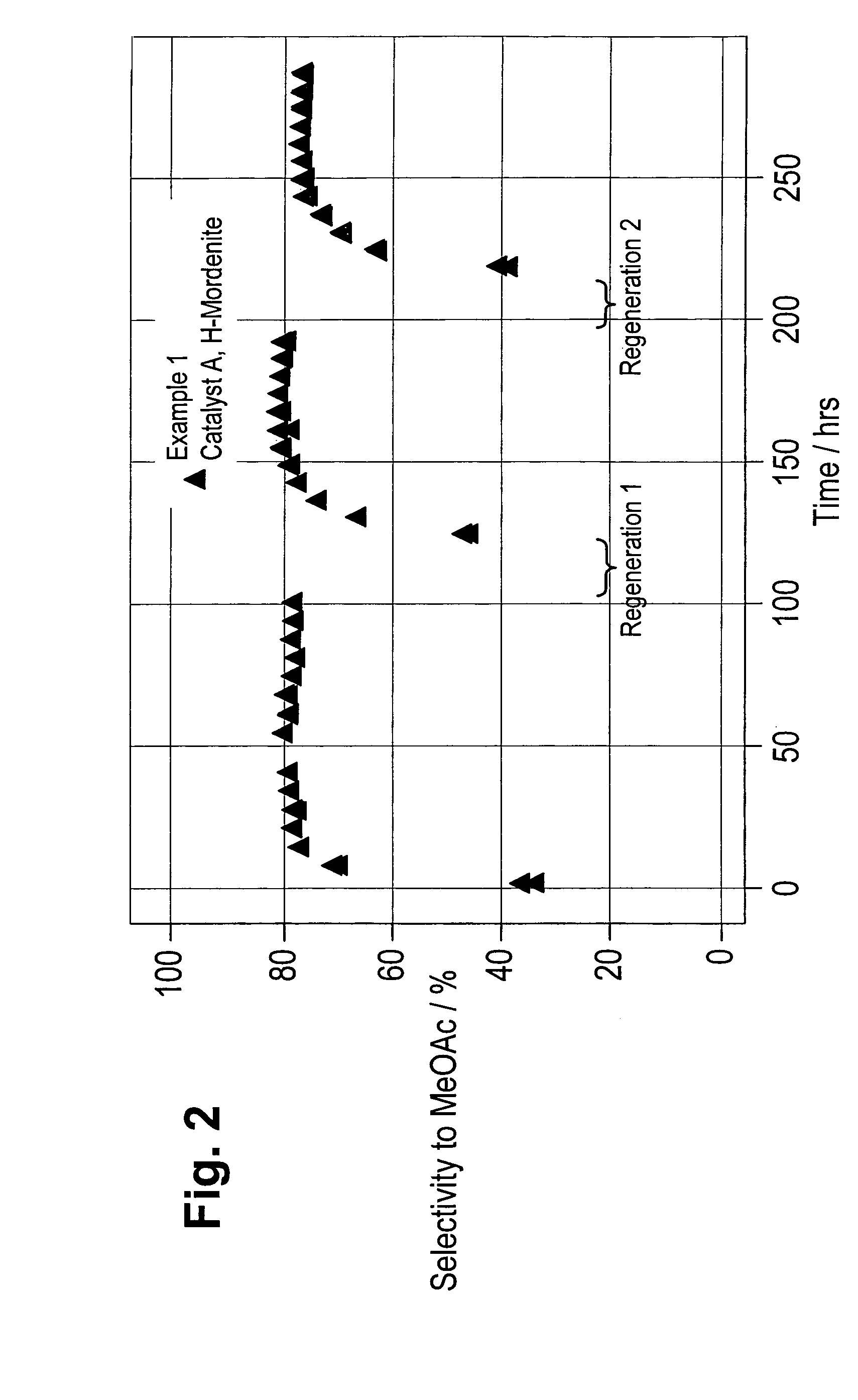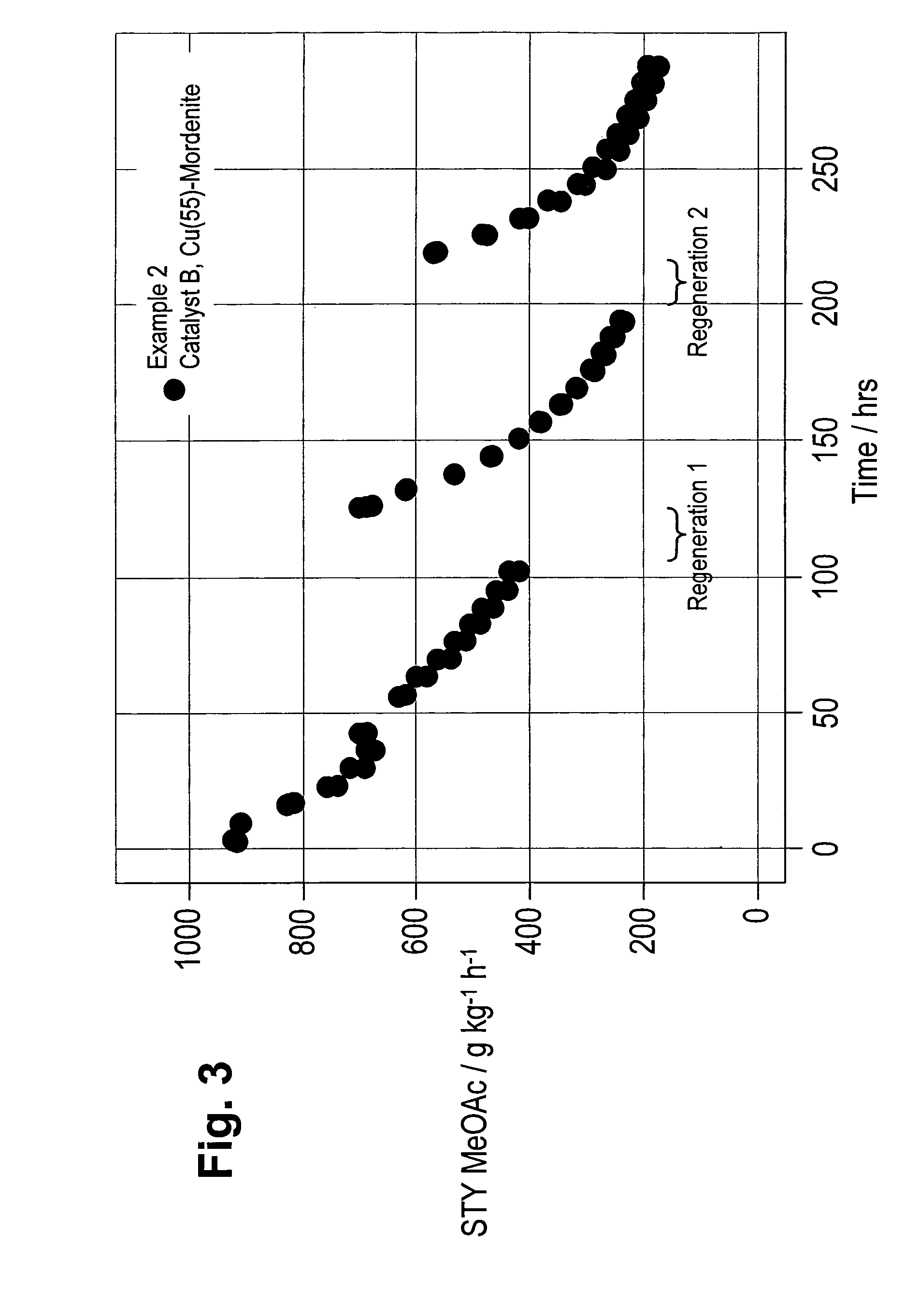Regeneration of zeolite carbonylation catalysts
- Summary
- Abstract
- Description
- Claims
- Application Information
AI Technical Summary
Benefits of technology
Problems solved by technology
Method used
Image
Examples
examples 3 to 5
Preparation of Catalyst C—Cu(55)-Mordenite
[0075]H-mordenite (80.1 g) with a silica to alumina ratio of 20 (ex Süd-Chemie) was weighed into a 1 litre round bottomed flask with a stirrer bar. 14.29 g of copper (II) nitrate hemipentahydrate was dissolved in a minimum amount of deionised water. This solution was then added to the mordenite along with sufficient deionised water to give a mobile slurry. The top of the flask was covered loosely and the flask left to stir overnight. The copper mordenite was then dried under reduced vacuum using a rotary evaporator before being dried in an oven at 90° C. for 1-2 hours. It was then calcined in a muffle oven (oven volume=18 L) under a static atmosphere of air at 500° C. for 3 hours after being heated at 90° C. for 2 hours and then at 110° C. for 2 hours. The copper mordenite was then compacted at 10 tonnes in a 13 mm die set using a pneumatic press and crushed and sieved to a particle size fraction of 125 to 160 microns. The mordenite had a co...
example 6
Preparation of Catalyst F—H-Mordenite
[0082]H-mordenite with a silica to alumina ratio of 20 (ex Süd-Chemie) was calcined in a muffle oven (oven-volume=18 L) under a static atmosphere of air. The temperature was increased from room temperature to 90° C. at a ramp rate of ca. 3° C. / min and then held at this temperature for 2 hours. The temperature was then increased to 110° C. at a ramp rate of ca. 1° C. / min and held at this temperature for 2 hours before finally being increased to a temperature of 500° C. at a ramp rate of ca. 3° C. / min and held at this temperature for 5 hours. The H-mordenite was then compacted at 12 tonnes in a 33 mm die set using a Specac Press, and then crushed and sieved to a particle size fraction of 212 to 335 microns.
Preparation of Catalyst G—Cu-(Ga)-Mordenite
[0083]NH4-(Ga) Mordenite (0.5 g) with a SiO2 to combined Ga2O3 and Al2O3 ratio of 19.4 and a Ga2O3:Al2O3 ratio of 1.5 (ex SINTEF) was weighed into a 5 mL phial and 755 microlitres of water added. 345 mic...
example 7
Preparation of Catalyst H—Cu(55)-Mordenite
[0086]H-Mordenite (500 g) with a silica to alumina ratio of 20 (CBV21A ex Zeolyst) and 90.5 g of copper (II) nitrate hemipentahydrate (98% ACS) were weighed into a 4 L round bottomed flask fitted with a stirrer. Sufficient deionised water (ca. 2 L) was added to the flask to obtain a thick slurry. The top of the flask was loosely covered and the flask left to stir overnight. The copper mordenite was then dried under reduced vacuum using a rotary evaporator before being dried in an oven at 90° C. for 1 hour. The dried copper mordenite was then calcined according to the procedure used in the preparation of catalyst G. The calcined copper mordenite was then compacted at 12 tonnes in a 33 mm die set using a Specac Press, and crushed and sieved to a particle size fraction of 250 to 500 microns. The mordenite had a copper loading of 55 mole % relative to aluminium contained in the mordenite.
Preparation of Catalyst I—Ag(55)-Mordenite
[0087]Silver mor...
PUM
| Property | Measurement | Unit |
|---|---|---|
| Temperature | aaaaa | aaaaa |
| Temperature | aaaaa | aaaaa |
| Partial pressure | aaaaa | aaaaa |
Abstract
Description
Claims
Application Information
 Login to View More
Login to View More - R&D
- Intellectual Property
- Life Sciences
- Materials
- Tech Scout
- Unparalleled Data Quality
- Higher Quality Content
- 60% Fewer Hallucinations
Browse by: Latest US Patents, China's latest patents, Technical Efficacy Thesaurus, Application Domain, Technology Topic, Popular Technical Reports.
© 2025 PatSnap. All rights reserved.Legal|Privacy policy|Modern Slavery Act Transparency Statement|Sitemap|About US| Contact US: help@patsnap.com



